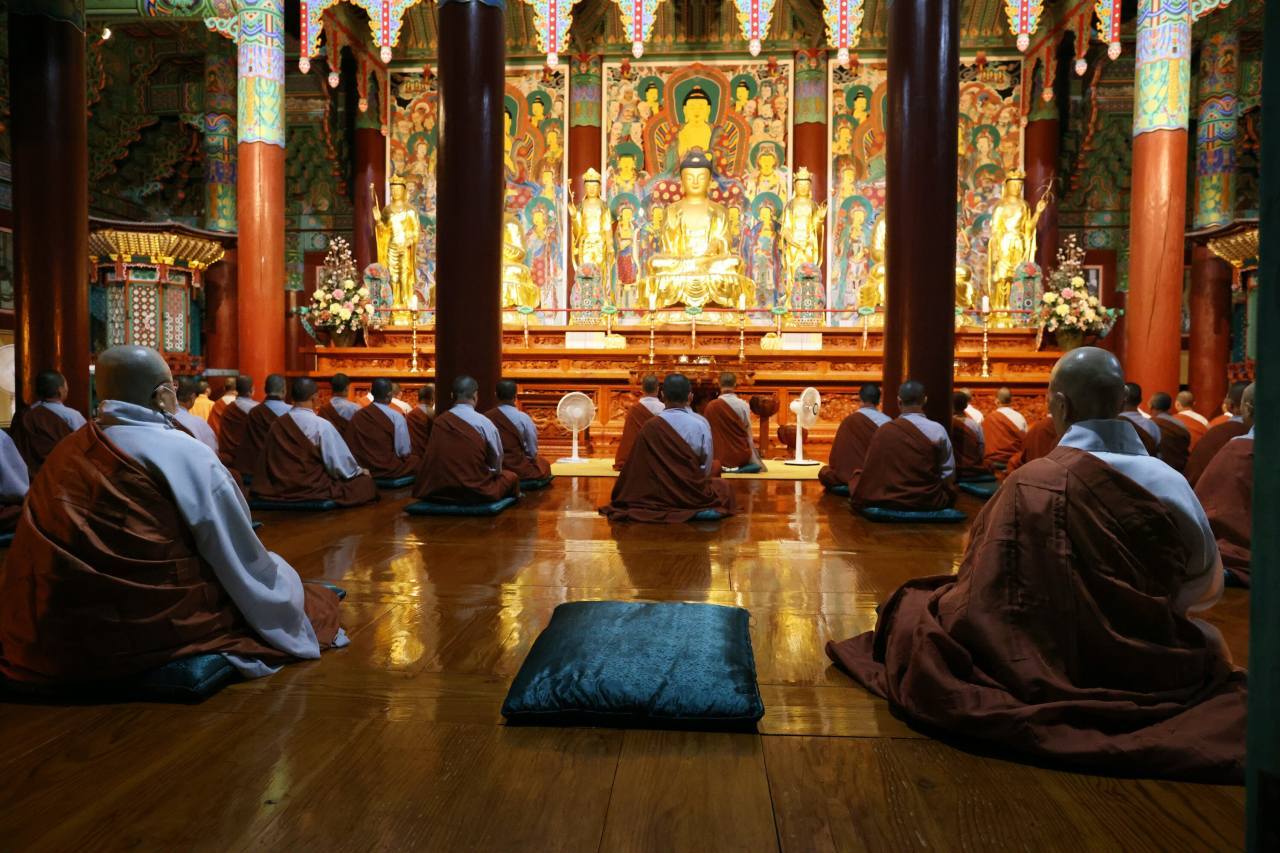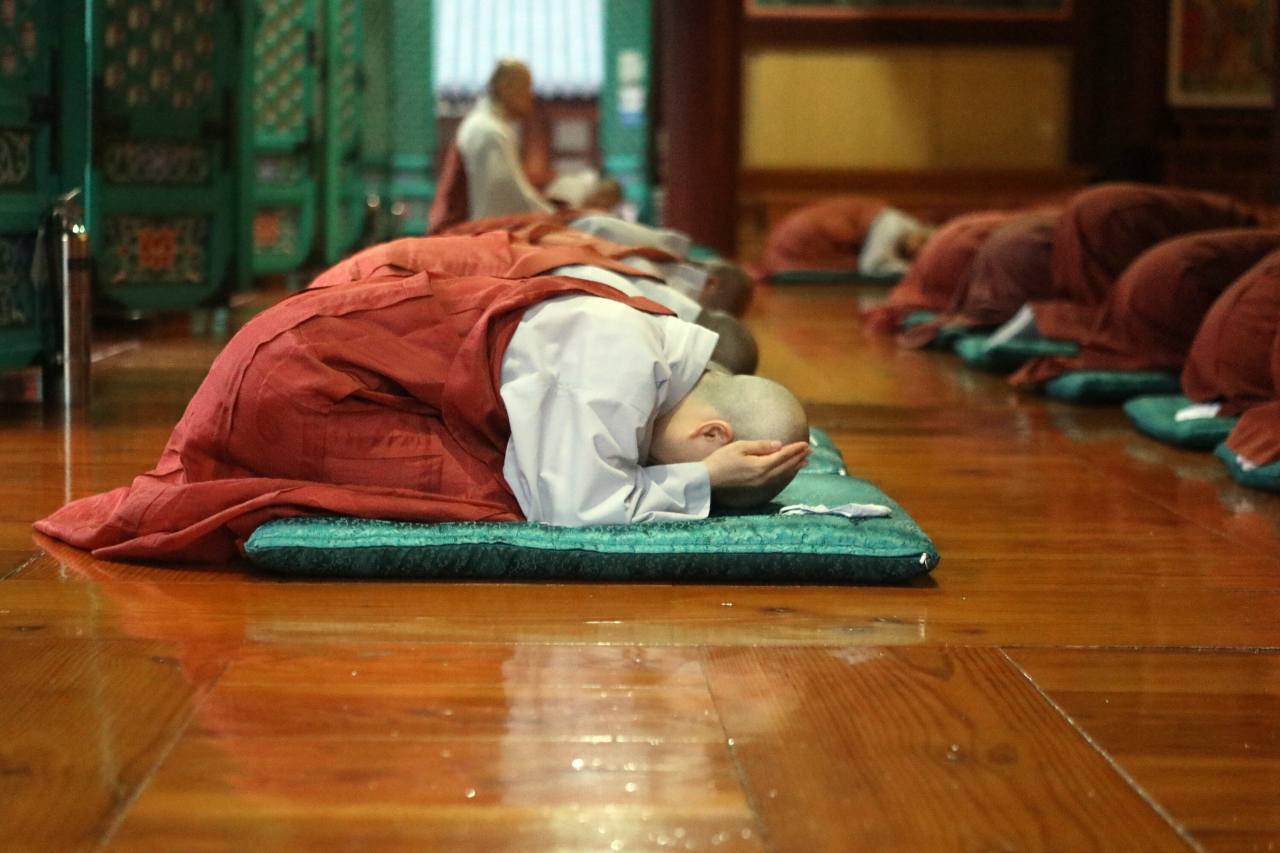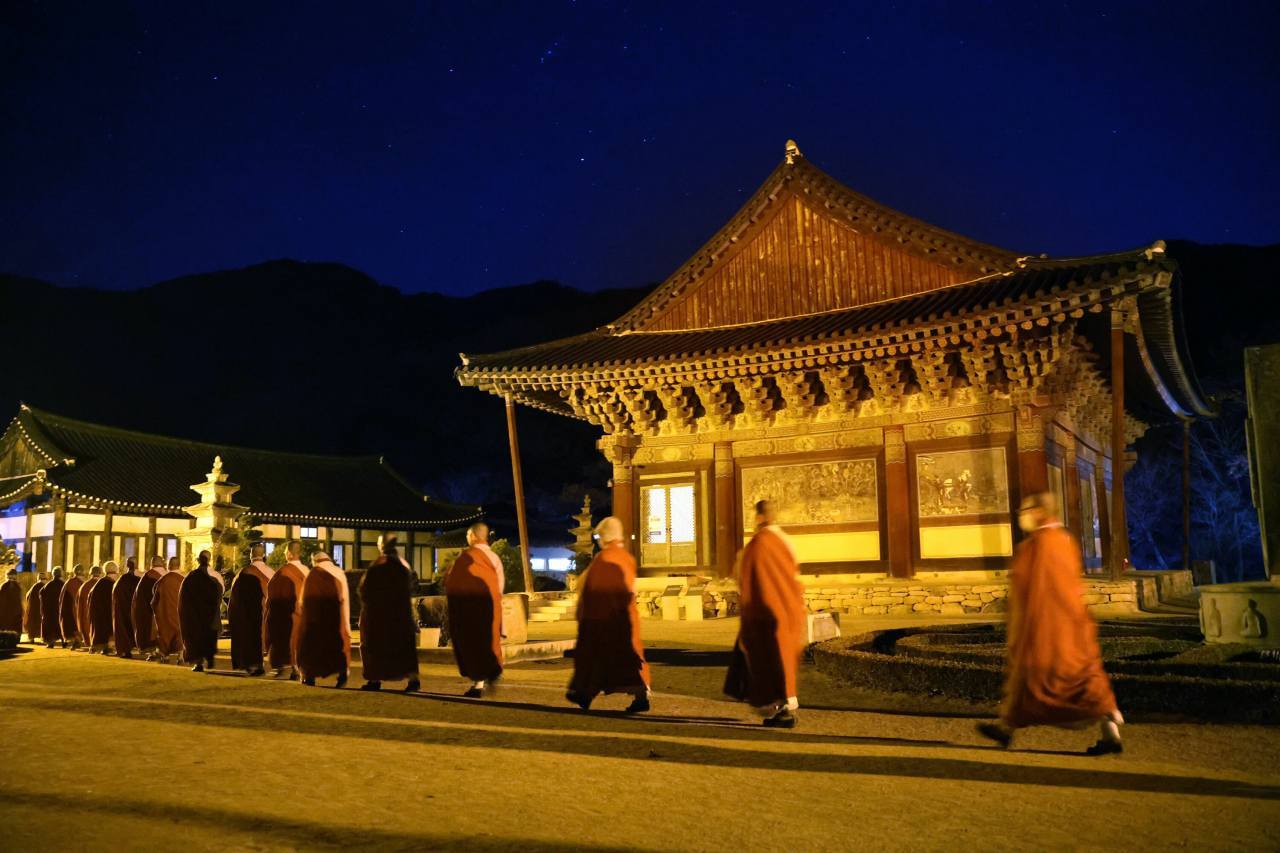 |
Nuns pray inside Daeungjeon building, designated as Korea’s National Treasure No. 835, at the Unmunsa Buddhist Nunnery University in Korea. (Hyungwon Kang) |
Women’s prominent role in Korean Buddhism goes way back in history.
Becoming a Buddhist nun or monk was a common life options for the ruling elites of the Silla Kingdom and Goryeo Empire which lasted more than 14 centuries from 57 BC to AD 1392.
Even kings and queens jettisoned their throne to become Buddhist monks and nuns during the Silla period, just as the Siddhartha Shakyamuni Buddha gave up his kingdom to become an enlightened one, some 2,600 years ago.
The oldest surviving book that was printed with movable metal types, the Jikji, has the name of a nun named Myodeok, a possible royal family member, who commissioned the printing of the book.
When Buddhist temples were destroyed and bronze statues melted to make coins and weapons during the 500 years of Neo-Confucian Joseon kingdom, Korean women’s names were often not recorded in genealogy books.
Women were mentioned only by her father’s family name in jokbo, or family tree books, next to full names of her husband and the couple’s children.
Leaving home to practice Buddhism as a clergy is called chulga, which literally means departing the family.
Today, some 6,000 Korean Buddhist nuns continue the tradition of leaving the family to practice Buddhism full time as a lifelong conviction.
 |
Nuns pray during a daily prayer meeting at the Unmunsa Buddhist Nunnery University. (Hyungwon Kang) |
About a third of all Buddhist Nuns in Korea have been educated at Korea’s largest Buddhist nunnery, the Unmunsa Buddhist Nunnery University in Cheongdo in North Gyeongsang Province.
The Unmunsa Buddhist Nunnery University was founded by Ven. Myeongseong, 91, one of the first female Buddhist teachers in Korea. Since 1970, the university has graduated nearly 2,200 students.
Ven. Myeongseong’s teachings have been published in an anthology which is considered a definitive body of Buddhist teachings for Korean Buddhism.
The highly disciplined curriculum at the Unmunsa Buddhist Nunnery University includes manual labor for everyone. Ven. Myeongseong instituted a work rule for her students, where everyone must perform some manual labor called “ulryeok” during the day or they do not eat.”
The Unmunsa temple has a vast amount of land around it, awarded during the Goryeo period, which is farmed exclusively by the nuns and students at the university. “We grow all our vegetables,” said the temple’s head professor Ven. Unsan.
Until Buddhist nuns are ordained officially after graduation from the Buddhist University, they are called samini seunim.
About three years after graduating from a university, samini seunim Dohyeon left her job and became a hakin, a student, at the Unmunsa Buddhist Nunnery University.
 |
Students and faculty march back to their campus following a morning prayer service at the Unmunsa Buddhist Nunnery University in Cheongdo, North Gyeongsang province. (Hyungwon Kang) |
Now a fourth-year student, samini seunim Dohyeon said she has come to realize that “the answers to all of humanity’s questions such as ‘Who am I and why am I here?’ were already addressed by the enlightened Siddhartha Buddha who had already figured out the answers to life’s quandaries some 26 centuries ago.”
The students at the Unmunsa Buddhist Nunnery University are taught everything, including how to properly spit, according to one of the graduates who attended the university some 20 years ago.
“We had about 60 students in our class back then. Admission to Unmunsa Buddhist Nunnery University, where everyone receives a full-tuition scholarship and lodging, was quite competitive,” said the graduate who did not want to be identified by her name.
“Along with the drop in Korea’s population growth, we have fewer applicants to our university. We only have a student body of about 100 hakin, plus professors and supporting staff totaling 152,” said Ven. Unsan, Ph.D., the head of the Unmunsa Buddhist Nunnery Temple, who manages the finances for both the temple and the University.
“For me, the most difficult part about adjusting at the Unmunsa Buddhist Nunnery University was having to share a common room with my entire class of 23 hakin,” said a third-year student who didn‘t want to be named. “It’s nice that we sleep together in one room, but that is also one of the difficulties.”
“I felt like I started over as a kid, learning correct habits like not walking on my heels but with my toes, chewing food with my mouth closed and properly using chopsticks. In fact, I became proficient in the use of chopsticks after I started living here,” said the third-year student.
Unmunsa Buddhist Nunnery University hakin students learn about half of their curriculum in Hanja characters.
Hanja characters have been the common written language of East Asia and most, if not all, Buddhist text books are in Hanja characters.
Today’s Buddhist books have pronunciation guides in Hangeul, the Korean writing system invented by King Sejong the Great in 1443, printed next to the Hanja character texts.
“The classes are taught about 50 percent in Hanja and the rest in Hangeul,” said Ven. Unsan.
By Hyungwon Kang (hyungwonkang@gmail.com) ---Korean American photojournalist and columnist Hyungwon Kang is currently documenting Korean history and culture in images and words for future generations. -- Ed.By Korea Herald (
khnews@heraldcorp.com)








![[Exclusive] Hyundai Mobis eyes closer ties with BYD](http://res.heraldm.com/phpwas/restmb_idxmake.php?idx=644&simg=/content/image/2024/11/25/20241125050044_0.jpg)
![[Herald Interview] 'Trump will use tariffs as first line of defense for American manufacturing'](http://res.heraldm.com/phpwas/restmb_idxmake.php?idx=644&simg=/content/image/2024/11/26/20241126050017_0.jpg)
![[Herald Review] 'Gangnam B-Side' combines social realism with masterful suspense, performance](http://res.heraldm.com/phpwas/restmb_idxmake.php?idx=644&simg=/content/image/2024/11/25/20241125050072_0.jpg)